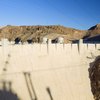Until the advent of a paved road system in the 1900s, stagecoach trails were the equivalent of interstates for convenient travel through the desert. Anza-Borrego Desert State Park in Southern California near San Diego is crisscrossed by trails, including several used by stagecoaches in the 1800s to deliver mail and passengers. You can explore these historic trails today on foot, horseback or four-wheeled vehicle.
History
Native people created the trails found in the area of the Anza-Borrego Desert State Park. Cahuilla and Kumenyaay were just two of the native people who created the trails as they passed between harvesting sites, water sources and their villages. Upon their arrival in the 1500s, Spanish explorers found the native trails, naturally widening them as their large parties passed over. Over time, the trails became well-utilized wagon roads en route to the California gold rush of the mid-1800s, and new ranching communities eagerly awaited mail delivered via horseback and stagecoach.
The Great Southern Overland Route
The Great Southern Overland Route was used by the Butterfield Stage between 1857 and 1861 on its winding passenger and mail route that originated in St. Louis, Missouri, and ended in San Francisco. The trip took 53 days and traversed 1,475 miles. It has been the most intensively used travel route throughout the history of the area and remains intact today. You can drive along this route on a two-lane paved road that runs from the southeast corner of the park at Carrizo Creek to San Felipe and the Cuyamacas on the western edge of the park. Other trails in the park utilized by stagecoaches include the San Diego Trail, where stagecoach riders were transferred onto mule back to traverse steep mountain passes, alternate spurs to Temecula and other points. These trails are suitable for hiking, mountain biking and horseback riding.
When to Visit
Summer temperatures can reach 125 degrees F in the park, so be sure to wear sun protection and bring plenty of water if you decide to visit in hot weather. The busiest season is in spring, when wildflowers turn the brown desert into seas of multicolored displays. The blooms can appear as early as February, but are dependent on rainfall and temperature. The park offers a postcard notification system in which you will be notified when peak blooms are expected. Autumn and winter see cooler temperatures, with temperatures returning to the 90s in October and dipping as low as the high 60s in January. If planning an overnight stay, prepare for the low 40s at night from December through early February.
Tips and Warnings
Much of the park is remote desert. If you are driving your vehicle in summer, have your vehicle serviced before attempting the journey, and carry extra belts and hoses, as the extreme heat can cause them to break. Even if you can't change them yourself, having the correct hoses on hand can save days of wait while they are couriered to the nearest mechanic shop your vehicle gets towed to. Rattlesnakes live in the desert, emerging in early spring. You can find them sunning themselves on pavement, trails or flat rocks, or cooling off under rocks or bushes. Be careful where you put your hands and feet when hiking.
Photo Credits
- Jupiterimages/liquidlibrary/Getty Images




